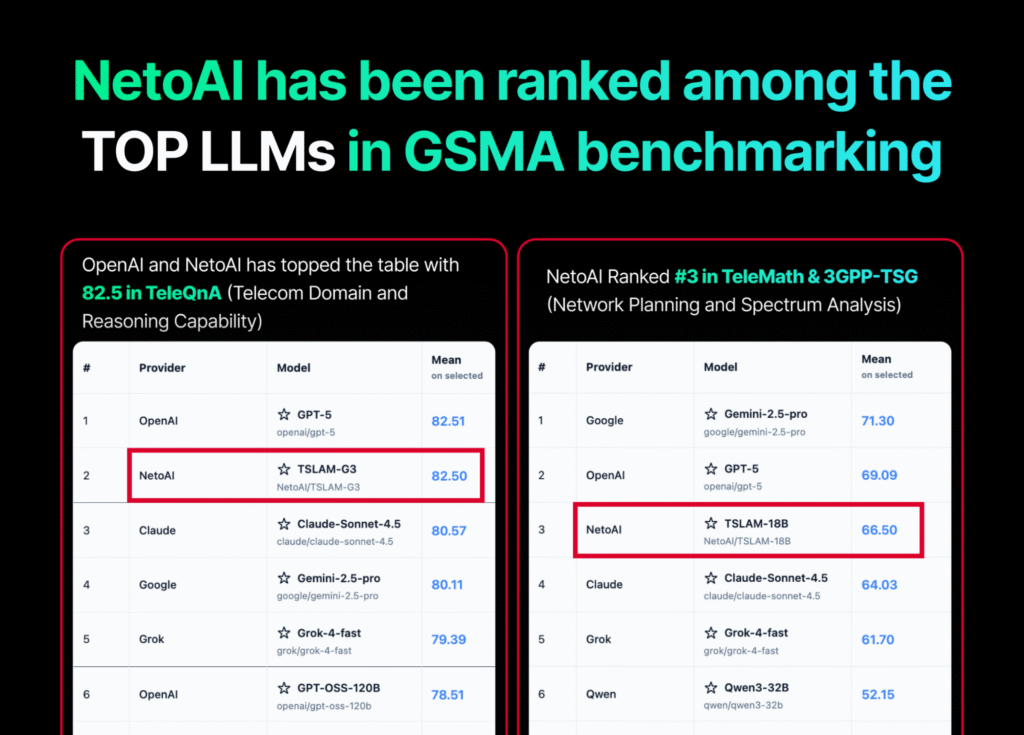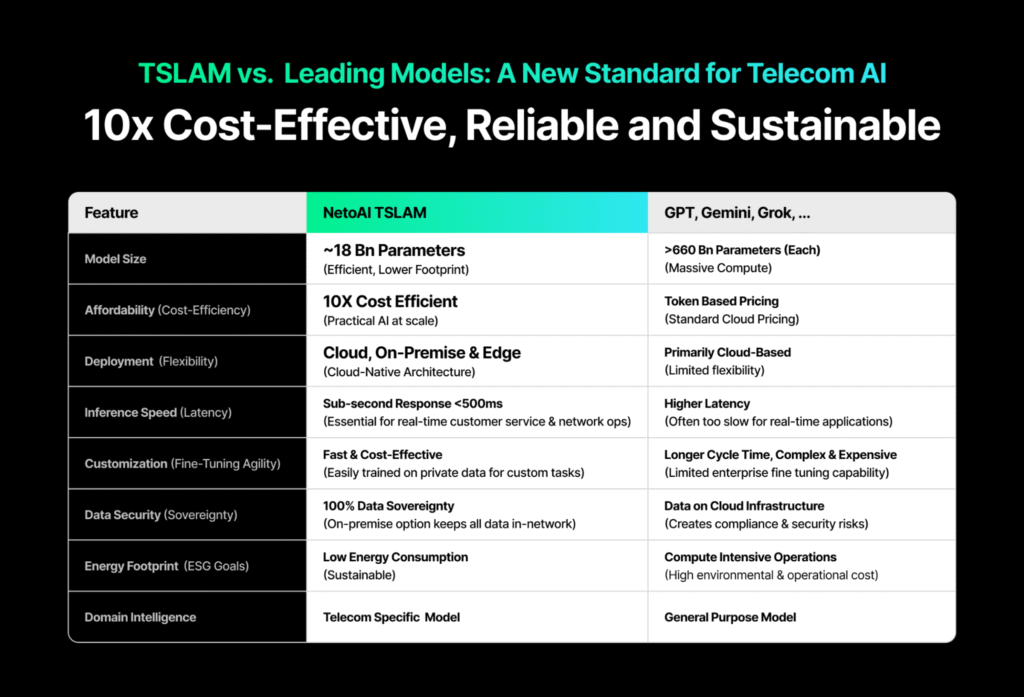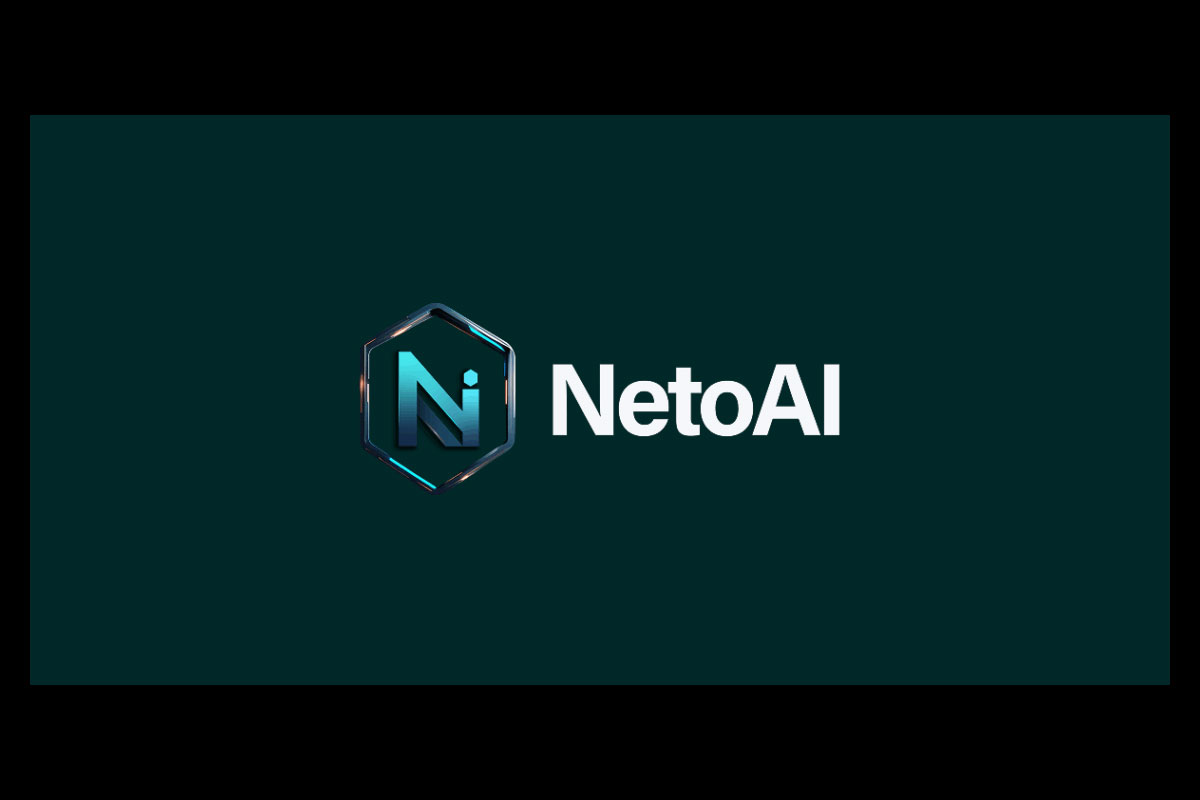Artificial intelligence is reshaping every industry, but few sectors stand to gain as much as telecommunications. Networks are becoming smarter, customers expect instant solutions, and operators are pushing toward automation at every layer of their infrastructure. In this evolving environment, NetoAI has emerged as a clear leader by developing specialized AI models tailored exclusively for the telecom ecosystem.
In the latest GSMA Open-Telco LLM Benchmarks 2.0, NetoAI’s purpose-built TSLAM (Telecom-Specific Large Language Model) family has achieved top rankings, outperforming or matching many of the world’s largest and most advanced general AI models. With three models—TSLAM-G3, TSLAM-18B, and TSLAM-2B MINI—earning recognition across different telecom tasks, the company has set a new benchmark for how intelligent, efficient, and secure AI can transform communication networks.
This milestone marks a clear shift in AI strategy for the telecom industry: away from generic, oversized models and toward specialized, optimized systems built for real-world telecom challenges.
The Rise of Purpose-Built AI in Telecom

Traditional AI models are massive, general-purpose systems trained on broad datasets. While powerful in general reasoning, they often fall short when applied to industry-specific tasks that require deep domain knowledge—like interpreting 3GPP standards, optimizing radio networks, or resolving customer issues tied to infrastructure.
Telecom operations involve massive datasets, strict security requirements, and highly technical workflows. From predictive maintenance and network optimization to customer support and fault diagnosis, each application demands a model that understands telecom vocabulary, logic, and context.
That’s where NetoAI’s specialized LLM approach shines. The company’s TSLAM models are engineered from the ground up with telecom data, structures, and performance needs in mind. Instead of treating telecom as a subset of general intelligence, NetoAI treats it as a primary domain, designing AI that thinks like a telecom expert.
A Benchmark-Winning Portfolio Built for Every Telecom Need
NetoAI’s TSLAM family isn’t a single monolithic AI—it’s a modular, strategic suite of models, each crafted for a specific segment of telecom operations. Together, they cover the full spectrum of intelligence needed in modern telecom—from customer interaction to deep engineering and edge processing.
1. TSLAM-G3 – The Knowledge Copilot
The TSLAM-G3 model stands at the top of the GSMA domain reasoning leaderboard, achieving an industry-leading score for telecom knowledge comprehension.
It’s designed as a Telecom Knowledge Copilot—a model that can instantly and accurately answer domain-specific questions, interpret documentation, and support telecom professionals in real time. Whether it’s explaining network configurations, summarizing complex standards, or guiding engineers through troubleshooting, TSLAM-G3 functions like a seasoned telecom analyst built into your AI stack.
By outperforming large, general models in domain reasoning, TSLAM-G3 proves that focused intelligence beats size when it comes to industry expertise.
2. TSLAM-18B – The Engineering Powerhouse
The TSLAM-18B model ranked among the top three globally in the GSMA benchmark’s TeleMath and Standards Comprehension categories. This model represents the Telecom Engineering Brain of NetoAI’s lineup—capable of tackling quantitative problems, reading technical diagrams, and interpreting advanced standards across 4G, 5G, and even early 6G frameworks.
What’s remarkable is that TSLAM-18B achieved this elite performance while being over 30 times smaller than the largest generalist models in the benchmark. Despite its compact design, its results were within 5% of the best-performing general AI models—proof that domain-optimized design can rival massive architectures at a fraction of the computational cost.
For telecom engineers, this translates into faster performance, reduced infrastructure load, and the flexibility to deploy AI closer to their network operations—all without sacrificing intelligence or accuracy.
3. TSLAM-2B MINI – Efficiency at the Network Edge

In an industry where real-time processing is critical, the TSLAM-2B MINI model stands out as a masterclass in edge-optimized AI. It’s lightweight, fast, and built for low-latency environments such as towers, routers, and field-deployed devices.
GSMA evaluators praised this model for maintaining strong accuracy while operating with minimal energy consumption, making it ideal for sustainable, large-scale deployment. For telecom operators expanding edge networks or IoT infrastructures, TSLAM-2B MINI offers a perfect balance between intelligence, power efficiency, and environmental responsibility.
Beyond Benchmarks: The Strategic Advantage of Specialization
While the GSMA results validate NetoAI’s technical leadership, the true power of the TSLAM models lies in the strategic advantages they offer operators. As telecom companies compete on efficiency, data control, and sustainability, the value of having tailored, controllable AI systems becomes undeniable.
1. Radical Efficiency by Design
Unlike enormous generalist AIs that demand vast computing resources, NetoAI’s models are built with efficiency first. TSLAM-18B achieves its benchmark-leading performance while using just a fraction of the parameters of 600-billion-plus models.
This design not only reduces operational costs but also minimizes latency—enabling real-time insights, faster decision-making, and lower carbon emissions.
2. Deployment Flexibility Across Every Environment
Telecom networks are diverse—spanning edge sites, data centers, and hybrid infrastructures. NetoAI’s TSLAM portfolio is designed to run anywhere:
- On-Premise: For operators prioritizing security and local data control.
- Edge: For latency-sensitive environments like network nodes and IoT devices.
- Hybrid Cloud: For scalable workloads that require dynamic resource allocation.
This deployment flexibility empowers telecom companies to customize how and where AI operates, aligning performance with business goals.
3. Total Data Sovereignty and Security
Data security isn’t optional—it’s a mandate. TSLAM’s architecture supports complete data sovereignty, ensuring that all sensitive network and customer data stays within the operator’s infrastructure.
This eliminates exposure to external cloud environments and simplifies compliance with data-protection regulations like GDPR. For operators handling millions of subscribers, such data assurance is a major competitive advantage.
4. Lower Total Cost of Ownership (TCO)
Because TSLAM models are optimized for resource efficiency, they require less computing power and storage. This directly reduces capital expenditure (CAPEX) and operational expenditure (OPEX).
By avoiding unpredictable consumption-based pricing models, operators can forecast costs more accurately and enjoy stable, scalable AI adoption. In simple terms: you get more intelligence for less money—and with no hidden costs.
5. Built-In Energy Efficiency and Sustainability
Telecom networks are global energy consumers, and sustainability has become a core strategic priority. TSLAM models are designed to support that mission.
Their compact architecture minimizes energy use during both training and inference. The smaller edge-ready models, especially TSLAM-2B MINI, dramatically cut down on power needs—helping telecom companies reduce carbon footprints without compromising intelligence or accuracy.
By embedding sustainability into AI design, NetoAI ensures that innovation aligns with environmental responsibility.
Why Bigger Isn’t Always Better
The GSMA benchmark data highlights an important truth: size no longer guarantees superiority. For years, the AI race was about building larger and larger models with trillions of parameters. But as telecom applications become more specialized, efficiency, accuracy, and adaptability matter more than raw scale.
NetoAI’s results show that smaller, domain-focused models can match or even outperform vast general-purpose AIs in telecom use cases. This changes how the industry views AI development—shifting the emphasis from size to smart design, domain expertise, and operational practicality.
The Smart Model for Smart Networks: TSLAM-18B’s Competitive Edge
Among the TSLAM portfolio, TSLAM-18B stands as the ideal balance between power, efficiency, and control. It offers high performance for complex engineering and operational tasks, yet remains compact enough for flexible deployment across cloud, hybrid, or local infrastructure.
Its near-parity performance with massive generalist models proves that telecom doesn’t need colossal, resource-hungry AI to achieve world-class results. What it needs is precision intelligence—and that’s exactly what TSLAM-18B delivers.
For operators looking to scale AI adoption without expanding costs or compromising security, TSLAM-18B is the most logical choice. It combines performance leadership with the practical benefits of customization, governance, and efficiency.
The Future of Telecom AI: Domain-Native Intelligence
The success of NetoAI’s TSLAM models represents more than just strong benchmark scores—it’s a turning point for the industry. Telecom AI is moving from generalist intelligence to domain-native ecosystems, where models are trained and optimized specifically for communication networks.
In this new era, telecom operators will rely on AI not only to answer queries or optimize traffic but also to power autonomous operations, intelligent troubleshooting, and proactive maintenance. The winners will be those who adopt purpose-built AI that understands their world deeply.
By offering a diversified yet unified model portfolio, NetoAI positions itself at the forefront of this transition. Each TSLAM model complements the other—delivering enterprise-grade intelligence for every level of the telecom stack.

Final Thoughts: A Smarter Path Forward for Telecom AI
The GSMA Open-Telco LLM Benchmarks 2.0 confirmed what many in the telecom sector have long suspected: specialized AI is the future. NetoAI’s remarkable performance across its TSLAM models proves that focus, precision, and domain expertise can outperform sheer size and power.
The company’s models—TSLAM-G3, TSLAM-18B, and TSLAM-2B MINI—offer telecom operators unmatched flexibility, security, and cost efficiency. They are designed for the realities of modern telecom, not the generalities of the internet.
As networks evolve toward 6G, intelligent automation, and sustainable operations, the demand for AI that understands telecom from the inside out will only grow. NetoAI has not just met that demand—it has set the standard.
In a world where “bigger” has long been mistaken for “better,” NetoAI’s philosophy proves that smarter, faster, and more efficient AI is what truly drives progress. For telecom operators building the networks of tomorrow, NetoAI’s TSLAM family isn’t just an option—it’s the new benchmark for intelligent performance.

